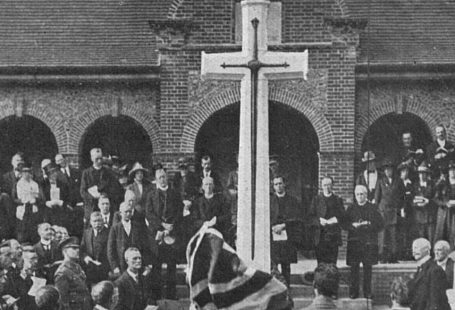We’ve recently donated 100 subscriptions to the Wikipedia community through the Wikipedia Library, a grant-funded programme which makes it easier for experienced volunteer editors to access research materials.
It’s very exciting to be involved in this new partnership. It allows us to contribute to Wikipedia, one of the most frequently used reference tools in the world, and demonstrates how local British and Irish newspapers can help improve public information about historical topics from around the world.
We asked Simon Tushingham, one of Wikipedia’s volunteer editors, to explain how The British Newspaper Archive has helped with his recent contributions.
**************

I have a History degree from the University of Cambridge and Wikipedia has always been a way for me to explore my interest in Indian and local history. When I got access to The British Newspaper Archive through the Wikipedia Library, I saw it as an opportunity to explore one of Salford’s local history mysteries.
Sir James Farmer
I discovered the mystery by speaking to several people who had been apprentices at the Sir James Farmer Norton & Co Ltd engineering firm at the Adelphi Ironworks in Salford.
None of them could really tell me anything about Sir James Farmer, though they knew lots about the products the company had manufactured. These were sold worldwide and many are still being used and resold now. Some of the products were truly innovative, such as a fast printing press.
The only information they really knew about Farmer was that he was once Mayor of Salford. Although the company did produce a celebratory booklet for an anniversary, there really doesn’t seem to have been much written about the man who started it all.
Starting Sir James Farmer’s Wikipedia article
 Because of his impact on my friends and our community, I suspected that Sir James Farmer may have been one of the more notable of the many self-made, often world-changing, engineering men who inhabited Manchester, Salford and the surrounding areas in the 19th century. He needed a Wikipedia article!
Because of his impact on my friends and our community, I suspected that Sir James Farmer may have been one of the more notable of the many self-made, often world-changing, engineering men who inhabited Manchester, Salford and the surrounding areas in the 19th century. He needed a Wikipedia article!
Wikipedia’s model for article development supports the ‘from little acorns…’ approach. If I could start an article about Farmer, then perhaps at some time in the future someone might find more information and add to it.
Wikipedia also has limitations. Inaccessible verifiable information usually means no article – it is meant to be an encyclopaedia, after all, so there needs to be some type of public and reliably documented conversation to show that it is of interest to the public. I couldn’t use the primary source material available at a couple of archives and there wasn’t really much else that I could find without trawling through microfilms.
Using The British Newspaper Archive
Enter The British Newspaper Archive! Forget spending days, probably weeks, twiddling at a film reader, I could get access to the most important information about Farmer with one simple search.
In the space of a couple of hours, most of which was spent being pleasantly distracted by other news articles surrounding the ones about Farmer, I’d gathered enough material to justify an article.
The man is now recognised on a major educational project that gets millions of viewers. I’ve planted that acorn and given him some of the recognition he deserves. Hopefully, given time, much more can be said about him and his company.
Sir James Farmer’s obituary
Here’s an example of what I was able to find at The British Newspaper Archive. Farmer’s obituary was published in the Manchester Times in 1892 and included an illustration of him:
Manchester Times – Friday 28 October 1892
Image © THE BRITISH LIBRARY BOARD. ALL RIGHTS RESERVED
**************
You can read Simon’s article about Sir James Farmer at Wikipedia.








4 comments On Working with Wikipedia to bring history facts to light
The Wikipedia article on Undecimus Stratton is based almost solely on one magazine article. One of Stratton’s listed achievements was setting a balloon altitude record of 7,000 feet in 1905 in the company of noted balloonist Frank Hedges Butler and noted automobile and aviation enthusiast The Honourable C. S. Rolls of Rolls-Royce fame (who would, in 1910, become the first person to die in an aeroplane accident in Britain).
Figuring that an altitude record was sure to be recorded in the newspapers, I decided to look for more details in the archive. I have found several interesting articles about ballooning in the 1905 newspapers. One, on page 6 of the 15 September 1905 issue of the Yorkshire Post and Leeds Intelligencer, tell of Mr. Stanley Spencer competing in a balloon race in Belgium and climbing to 9,000 feet. An earlier article, from page 2 of the 22 April 1905 issue of the Morpeth Herald, was about the history of ballooning, and mentioned an ascent in Berlin in 1900 where the balloonists, who had prepared themselves with a supply of oxygen, had ascended to 33,700 feet. Then, from page 5 of the 2 September 1905 issue of the Aberdeen Journal, came the news of Percival Spencer (Stanley’s brother?) and Frank Hedges Butler photographing an eclipse from a balloon… and being blown across the Channel on the way down!
There was also news about two balloons from the Aero Club that began racing each other. The Aberdeen Journal, on page 7 of its 31 October 1905 issue, and the Lichfield Mercury, on page 2 of its 3 November 1905 issue, report that one balloon contained Professor Huntington, J. Moore Brabazon, and The Hon. C. S. Rolls, while the other contained C. F. Pollock, F(rank). H(edges). Butler, and Martin Dale. At one point, the first balloon “shot upward at great speed” to “an altitude of about 7,000 feet”.
It is interesting to note that the articles do not mention 7,000 feet being any kind of record, that F. H. Butler was not in the balloon that “shot upward” to “about 7,000 feet”, and that the name of Undecimus Stratton is not mentioned in any of these articles.
The author of that magazine article has got some esplainin’ to do.
How interesting. Good research, Sam.
I too edit on Wikipedia, and have just read the entry Sam wrote there. It has good info but no illustrations at all (whereas this blog post does have). It has not risen above the status of a start-class on Wikipedia, partly because of this.
The problem I find is that the BNA will not allow Wikipedia articles like this to be illustrated by the odd ‘de minimis’ clipping or image from a BNA newspaper page (we are not talking of a large article or whole page). Copyright is not a problem (it still belongs to the original owner), nor is linking back to the page where the clipping is. The problem is that Wikipedia insists on a “Creative Commons Attribution-Share Alike 3.0 Unported” license which basically means anything can be done to the image as long as the copyright owner is credited.
And this is where the whole stack of cards breaks down. ‘Anything’ includes potentially using the small clipping or image commercially (however unlikely this is) and permission for this is generally never given by the copyright owners of BNA newspapers. There is no concept of ‘fair use’ in UK copyright law and commercial uses generally cost money.
It is not the BNAs fault per se, but it is a crying shame that an article such as Sam’s cannot be illustrated with, say, the image of Farmer shown above.
Oops Simon not Sam!!!